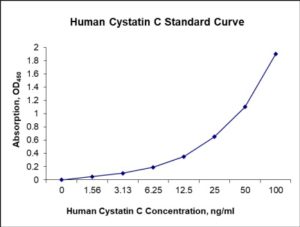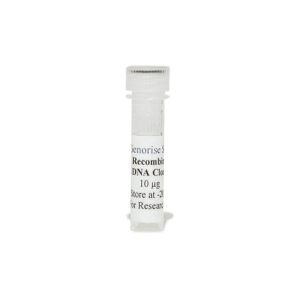Nori Human Cystatin C ELISA Kit
$461.00 – $832.00
This ELISA kit is for quantification of cystatin C in human. This is a quick ELISA assay that reduces time to 50% compared to the conventional method, and the entire assay only takes 3 hours. This assay employs the quantitative sandwich enzyme immunoassay technique and uses biotin-streptavidin chemistry to improve the performance of the assays. An antibody specific for CST3 has been pre-coated onto a microplate. Standards and samples are pipetted into the wells and any CST3 present is bound by the immobilized antibody. After washing away any unbound substances, a detection antibody specific for CST3 is added to the wells. Following wash to remove any unbound antibody reagent, a detection reagent is added. After intensive wash a substrate solution is added to the wells and color develops in proportion to the amount of CST3 bound in the initial step. The color development is stopped, and the intensity of the color is measured.
Alternative names for cystatin C: cystatin 3, CST3, gamma trace, post-gamma-globulin, or neuroendocrine basic polypeptide
This product is for laboratory research use only not for diagnostic and therapeutic purposes or any other purposes.
- Description
- How Elisa Works
- Product Citation (0)
- Reviews (0)
Description
Nori Human Cystatin C ELISA Kit Summary
Alternative names for cystatin C: cystatin 3, CST3, gamma trace, post-gamma-globulin, or neuroendocrine basic polypeptide
| Assay Type | Solid Phase Sandwich ELISA |
| Format | 96-well Microplate or 96-Well Strip Microplate |
| Method of Detection | Colorimetric |
| Number of Targets Detected | 1 |
| Target Antigen Accession Number | P01034 |
| Assay Length | 3 hours |
| Quantitative/Semiquantitative | Quantitative |
| Sample Type | Plasma, Serum, Cell Culture, Urine, Cell/Tissue Lysates, Synovial Fluid, BAL, |
| Recommended Sample Dilution (Plasma/Serum) | No dilution for sample <ULOQ; sufficient dilution for samples >ULOQ |
| Sensitivity | 300 pg/mL |
| Detection Range | 1.56-100 ng/mL |
| Specificity | Human cystatin C |
| Cross-Reactivity | < 0.5% cross-reactivity observed with available related molecules, < 50% cross-species reactivity observed with species tested. |
| Interference | No significant interference observed with available related molecules |
| Storage/Stability | 4 ºC for up to 6 months |
| Usage | For Laboratory Research Use Only. Not for diagnostic or therapeutic use. |
| Additional Notes | The kit allows for use in multiple experiments. |
Standard Curve
Kit Components
1. Pre-coated 96-well Microplate
2. Biotinylated Detection Antibody
3. Streptavidin-HRP Conjugate
4. Lyophilized Standards
5. TMB One-Step Substrate
6. Stop Solution
7. 20 x PBS
8. Assay Buffer
Other Materials Required but not Provided:
1. Microplate Reader capable of measuring absorption at 450 nm
2. Log-log graph paper or computer and software for ELISA data analysis
3. Precision pipettes (1-1000 µl)
4. Multi-channel pipettes (300 µl)
5. Distilled or deionized water
Protocol Outline
1. Prepare all reagents, samples and standards as instructed in the datasheet.
2. Add 100 µl of Standard or samples to each well and incubate 1 h at RT.
3. Add 100 µl of Working Detection Antibody to each well and incubate 1 h at RT.
4. Add 100 µl of Working Streptavidin-HRP to each well and incubate 20 min at RT.
5. Add 100 µl of Substrate to each well and incubate 5-30 min at RT.
6. Add 50 µl of Stop Solution to each well and read at 450 nm immediately.
Background:
Cystatin C or cystatin 3 (formerly gamma trace, post-gamma-globulin, or neuroendocrine basic polypeptide), a protein encoded by the CST3 gene, is mainly used as a biomarker of kidney function. Cystatin C belongs to the type 2 cystatin gene family and has a low molecular weight (13.3 kilodaltons). Recently, it has been studied for its role in predicting new-onset or deteriorating cardiovascular disease. It also seems to play a role in brain disorders involving amyloid, such as Alzheimer’s disease. In humans, all cells with a nucleus produce cystatin C as a chain of 120 amino acids. It is found in virtually all tissues and body fluids. It is a potent inhibitor of lysosomal proteinases and probably one of the most important extracellular inhibitors of cysteine proteases. Cystatin C is removed from the bloodstream by glomerular filtration in the kidneys. If kidney function and glomerular filtration rate decline, the blood levels of cystatin C rise. Cross-sectional studies suggest that serum levels of cystatin C are a more precise test of kidney function than serum creatinine levels.[1] Cystatin C levels are less dependent on age, gender, ethnicity and muscle mass compared to creatinine. Cystatin C measurements alone have not been shown to be superior to formula-adjusted estimations of kidney function.[2] As opposed to previous claims, cystatin C has been found to be influenced by body composition.[3] It has been suggested that cystatin C might predict the risk of developing chronic kidney disease, thereby signaling a state of ‘preclinical’ kidney dysfunction.[4] Cystatin C levels have been reported to be altered in patients with cancer,[5] (even subtle) thyroid dysfunction[6] and glucocorticoid therapy in some[7] but not all[1] situations. The levels may be influenced by cigarette smoking and levels of C-reactive protein[8] and seem to be increased in HIV infection, which might or might not reflect actual renal dysfunction.[9] The role of cystatin C to monitor GFR during pregnancy remains controversial. Like creatinine, the elimination of cystatin C via routes other than the kidney increase with worsening GFR. Cystatin C levels are decreased in atherosclerotic and aneurysmal lesions of the aorta[10], but increased levels may be associated with the risk of death.
References
- Roos JF, et al. (2007). Clin. Biochem. 40 (5–6): 383–391.
- Stevens LA, et al. (2008). Am. J. Kidney Dis. 51 (3): 395–406.
- Shlipak MG (2007). Nat Clin Pract Nephrol. 3 (4): 188–189.
- Shlipak MG, et al. (2006). Annals of Internal Medicine. 145 (4): 237–46.
- Demirtaş S, et al. (2006). Clin. Biochem. 39 (2): 115–118.
- Fricker M, et al. (2003). Kidney Int. 63 (5): 1944–1947.
- Risch L, et al. (2001). Clin. Chem. 47 (11): 2055–9.
- Knight EL, et al. (2004). Kidney Int. 65 (4): 1416–1421.
- Odden MC, et al. (2007). Arch. Intern. Med. 167 (20): 2213–2219.
- Shi GP, et al. (1999). J. Clin. Invest. 104 (9): 1191–1197.
Be the first to review “Nori Human Cystatin C ELISA Kit”
You must be logged in to post a review.





























Reviews
There are no reviews yet.